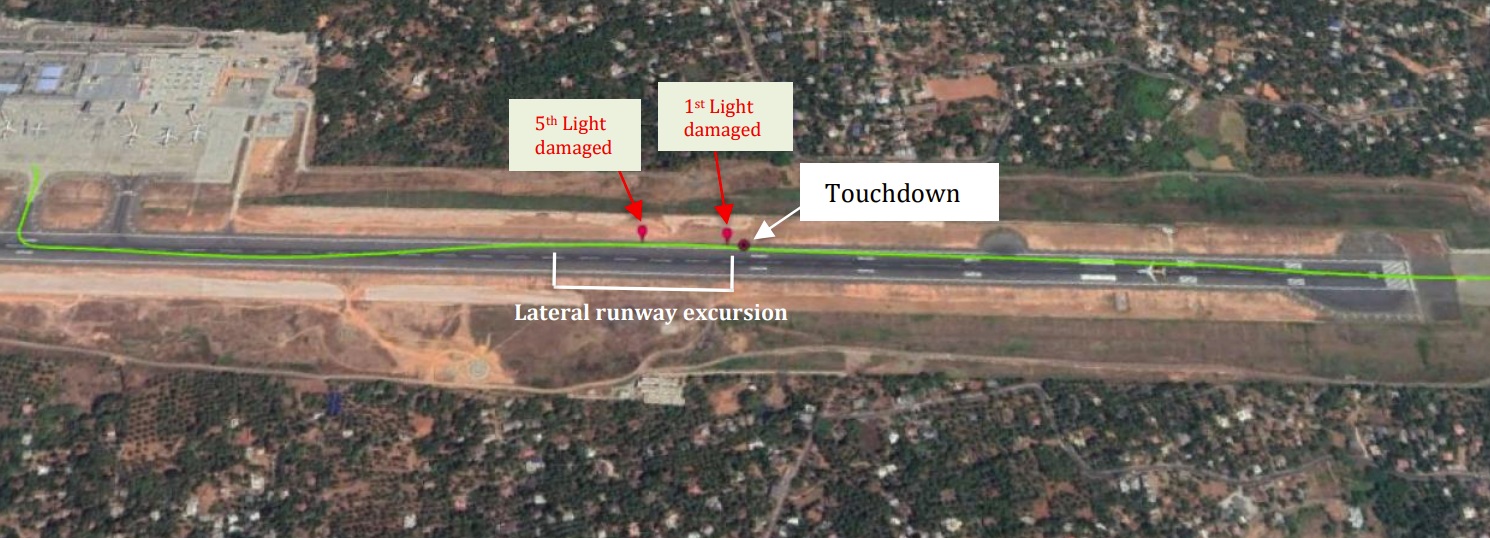
ASN Wikibase Occurrence # 241082
This information is added by users of ASN. Neither ASN nor the Flight Safety Foundation are responsible for the completeness or correctness of this information.
If you feel this information is incomplete or incorrect, you can submit corrected information.
| Date: | Friday 21 June 2019 |
| Time: | 05:10 LT |
| Type: |  Airbus A320-232 |
| Owner/operator: | Etihad Airways |
| Registration: | A6-EIT |
| MSN: | 5791 |
| Year of manufacture: | 2013 |
| Engine model: | IAE V2527-A5 |
| Fatalities: | Fatalities: 0 / Occupants: 124 |
| Aircraft damage: | Minor |
| Category: | Incident |
| Location: | Calicut International Airport (VOCL) -
 India India
|
| Phase: | Landing |
| Nature: | Passenger - Scheduled |
| Departure airport: | Abu Dhabi International Airport (AUH/OMAA) |
| Kozhikode-Calicut Airport (CCJ/VOCL) | |
| Investigating agency: | GCAA |
| Confidence Rating: |
An Etihad Airways, Airbus A320-232, registration A6-EIT, operated a scheduled passenger flight EY250, from Abu Dhabi International Airport, the United Arab Emirates, to Calicut International Airport, India. There were 124 persons onboard, comprising 116 passengers, two flight crewmembers, and six cabin crewmembers.
During the ILS approach to runway 28, the flight crew initiated a go-around due to heavy rain over the runway as reported by air traffic control (ATC). Approximately 16 minutes later, the flight crew initiated a second instrument landing system (ILS) approach to runway 28. On landing, the aircraft touched down to the right of the runway centerline, and the right main landing gear then struck five runway edge lights. The commander was able to steer the aircraft to the centerline and continue the landing roll uneventfully.
The Air Accident Investigation Sector of the United Arab Emirates (AAIS) determines that the cause of the Incident was that after crossing the threshold, the aircraft drifted towards the right side of the runway due to a slight but continuous roll input to the right. The aircraft touched down almost at the runway edge line, and this was followed by an increase in lateral deviation towards the runway edge due to the application of an ineffective flight control
recovery technique. The aircraft then struck and damaged five runway edge lights as the right main landing gear entered the runway shoulder.
(a) The presence of a moderate intensity rain shower over the runway during the landing affected visibility after the Aircraft crossed the threshold.
(b) The lack of runway centerline lighting.
(c) The situational awareness of the Commander, as the pilot flying, was adversely affected by his expectation that the Aircraft would remain aligned with the centerline until touchdown, since the Aircraft was aligned when he overflew the centerline at the threshold. The alignment deviation occurred because of the reduction in visibility over the threshold, and the lack of runway centerline lighting that resulted in a loss of visual references.
(d) The several unintentional roll inputs to the right applied due to a subconscious action, since the pilot flying focused more on the Aircraft pitch attitude during the flare and the reduction in pilot flying situational awareness.
(e) Control inputs to re-align the Aircraft were not affirmative in that only incremental left rudder inputs were made without an associated left roll. A continuous increase in the Aircraft lateral deviation movement was a result of the ineffective flight control technique, and this was due to the existing high workload and the surprise effect of the unexpected Aircraft lateral deviation position such that the pilot flying overlooked the approved flight control technique before touchdown.
(f) The recovery action to take the Aircraft back to the centerline by applying right rudder input after touchdown, was relatively late due to the high workload.
Initially the pilot flying applied an incorrect continuous left rudder input after touchdown.
(g) Despite his awareness of the deviation to the right of the runway centerline, the Co-pilot, as the pilot monitoring, did not intervene to attract the attention of the Commander. This was not in compliance with standard operating procedures.
Accident investigation:
 |
|
Sources:
GCAA
https://www.flightradar24.com/data/flights/ey250#20f8dcb7
Images:

Photo: GCAA
Revision history:
| Date/time | Contributor | Updates |
|---|---|---|
| 09-Sep-2020 08:38 | harro | Added |
| 09-Sep-2020 08:46 | harro | Updated [Date, Time, Narrative, Photo, Accident report, ] |
Corrections or additions? ... Edit this accident description
The Aviation Safety Network is an exclusive service provided by:


 ©2024 Flight Safety Foundation
©2024 Flight Safety Foundation